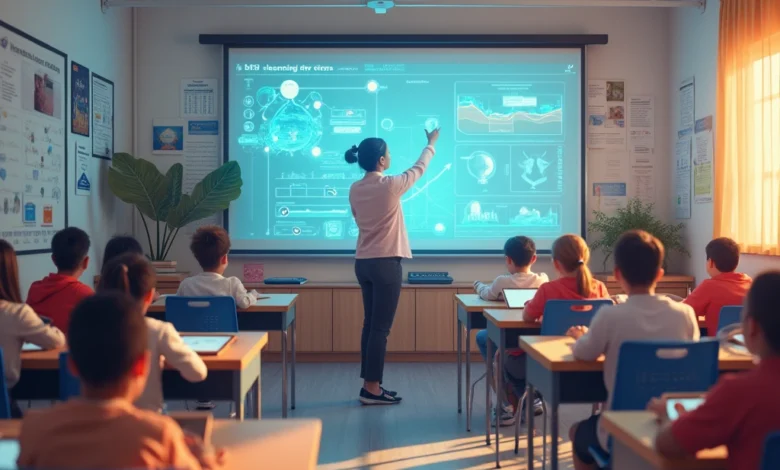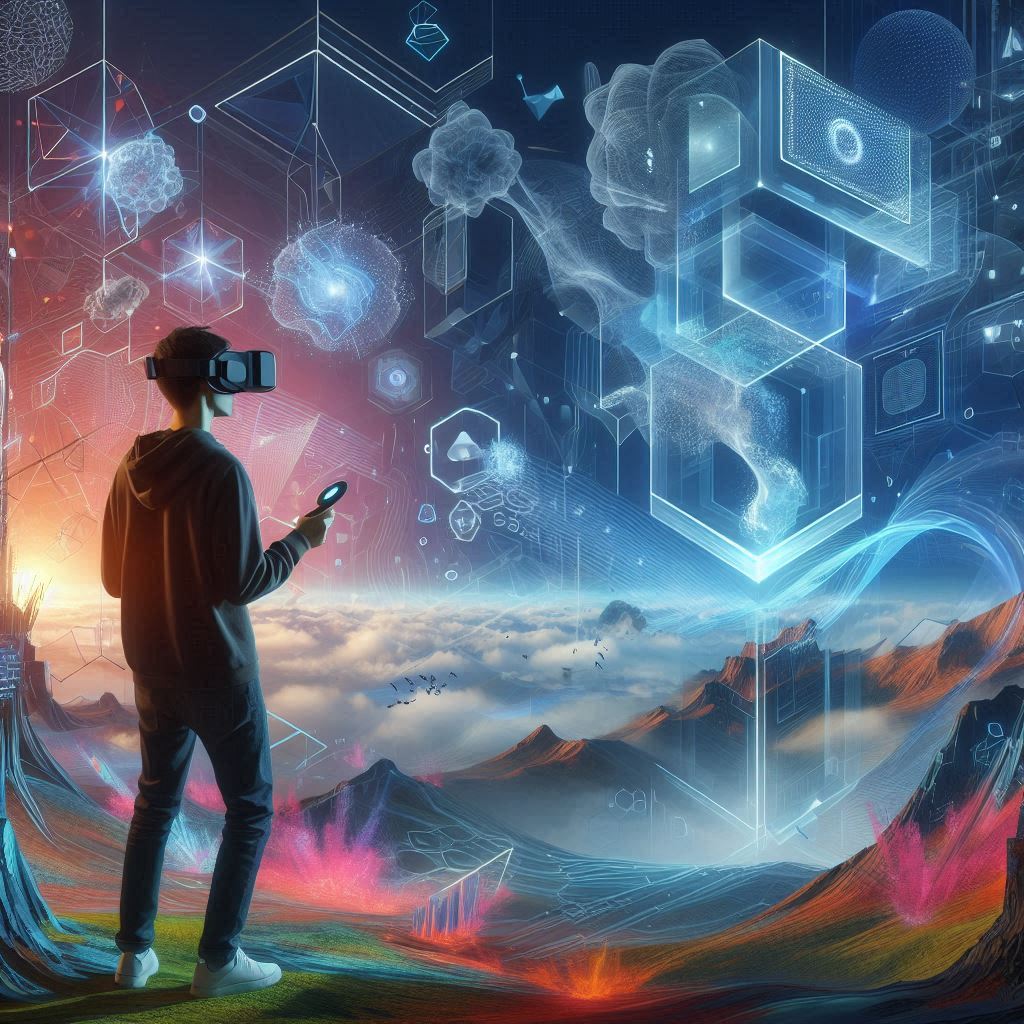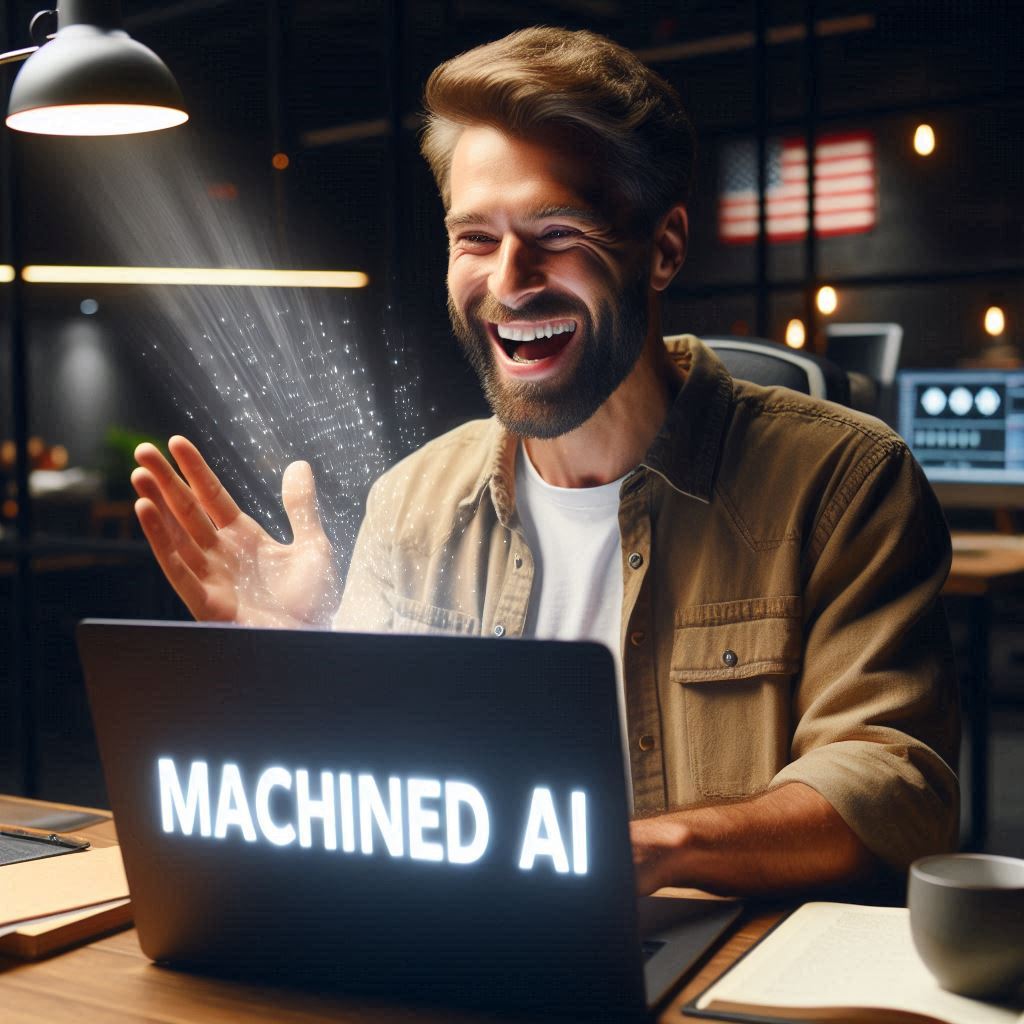
2025 AI in Education Trends: Thinking about the future of education? It’s key to know how artificial intelligence will shape it. The federal government plans to release a toolkit for AI in education in October 2024. This move is part of a growing trend in 2025.
AI is becoming more common in schools, but many use it without clear guidance. This shows a need for better direction in K-12 education. Expect to see more AI tools in 2025, designed to meet specific student needs.
AI is set to change how students learn. Online program leaders will start using generative AI in teaching by 2025. Also, over 64 percent of parents think AI can help teachers with their work. This shows AI’s growing role in education.
AI in Education Trends: Key Takeaways
- The federal government’s toolkit for AI integration is set to be released in October 2024.
- Many schools are adopting AI with minimal actionable guidance from leadership.
- Custom Generative Pre-trained Transformers (GPTs) and AI chatbots are being developed by early adopter educators.
- Online program leaders will begin to integrate generative AI into the instructional design process by 2025.
- More than 64 percent of parents agree that AI should relieve teachers of administrative tasks.
- AI is anticipated to play a larger role in education, specifically in test preparation and course planning.
The Current State of AI in Education
Schools now focus on teaching students about AI safety, privacy, and ethics. This is key to making sure students have a safe place to learn. The world of AI in education is changing fast, with new tech coming out all the time. It’s important to keep up with the latest trends.
AI tools in schools offer many benefits. They can tailor learning to each student, grade work automatically, and give feedback right away. These tools help teachers create plans that fit their skills and goals. AI also makes it easier to track education progress and log professional development.
Here are some important facts about AI in education:
- The number of AI graduates in the U.S. has grown a lot in the last ten years.
- Generative AI tools help teachers make learning plans that fit each educator’s background and goals.
- AI tools can create learning plans based on a teacher’s past experiences and skills.
The use of AI in education is only going to grow. New tech and ideas are coming out every day. As we look to the future, it’s crucial to keep up with the latest in educational technology and see how AI can make education better.
Emerging AI in Education Trends 2025
Looking ahead, machine learning will change how we learn in classrooms. Digital learning trends are making big changes in schools. A recent study found that 57% of workers think AI makes them more efficient
This shift to AI in education will deeply affect how we teach and learn. It will also change how schools run and make decisions. As AI grows, schools must keep up and adapt quickly. The need for AI literacy programs in colleges will grow as people want to understand AI’s benefits and risks.
AI will impact higher education in 2025 in several key ways:
- Teaching and learning
- AI literacy and career readiness
- Operations and decision-making
These areas will be crucial in shaping education’s future. They will help ensure students are ready for an AI-driven world.
As we move forward, we must think about AI’s benefits and challenges in education. By understanding these trends and technologies, we can make learning more effective and efficient for everyone.
| Area of Impact | Description |
|---|---|
| Teaching and Learning | AI-powered adaptive learning platforms |
| AI Literacy and Career Readiness | Programs focused on developing AI skills |
| Operations and Decision-Making | AI-driven analytics for improved decision-making |
AI in Education Trends: Personalized Learning Revolution
Exploring ai applications in education reveals a big change. Adaptive learning systems are making learning more personal. AI tools help teachers tailor lessons to each student’s needs and learning style. This move towards personalized learning is growing fast, with ed-tech expected to reach nearly $350 billion by 2030.
Adaptive learning platforms and custom curriculum generation allow for tailored lessons and feedback. This helps students learn at their own pace. Studies show that 57% of workers think generative AI makes them more efficient. Also, AI tutoring aids track progress in real-time, and meeting students where they are.
Some main benefits of personalized learning with AI include:
- Improved student engagement and motivation
- Enhanced learning outcomes and academic achievement
- Increased efficiency and productivity for educators
When looking at ai in education, remember the goal is to meet each student’s needs. Using these technologies, teachers can make learning more effective and efficient. This leads to better results for students.
AI in Education Trends: Virtual and Augmented Reality Integration
The future of learning is changing fast, thanks to tech. Virtual and augmented reality are key parts of this change. They make learning fun and interactive, helping students understand and remember more.
Virtual and augmented reality offer many benefits in education. They can turn virtual labs into real ones, letting students safely try experiments. They also make complex topics easy to grasp through interactive simulations11. Plus, they help create learning plans that fit each student’s needs.
Some big trends in using virtual and augmented reality include:
- More use in STEM subjects
- More interactive and immersive learning
- Focus on learning that fits each student
As schools get more into virtual and augmented reality, they need clear rules for using AI. It’s also important to teach everyone about AI’s good and bad sides.
In short, virtual and augmented reality are changing education for the better. As tech keeps evolving, we must keep up with the latest in AI for education.
AI in Education Trends: AI-Powered Assessment Systems
Artificial intelligence in education is changing how we assess students. AI-powered systems are becoming common in schools. They make grading faster and more accurate, so teachers can focus on teaching.
These systems turn AI from a challenge to a helper. They improve how we teach and learn. This leads to better grades for students, as AI helps spot where they need extra help.
AI assessment tools offer many benefits. They grade automatically, track student progress in real-time, and predict success. Tools like Gradescope make grading STEM subjects up to 70% faster. They also cut down on paperwork, saving teachers up to 40% of their time.
AI is changing how we assess students. It makes grading more efficient and personal. This helps students succeed better.
AI in Education Trends: Smart Content Creation and Curation
The future of AI in education is changing how we make and pick educational content. Machine learning helps teachers create smart learning tools. These tools make learning better and more personal for students13.
Generative AI tools make fun and interactive stuff like videos and games. They fit different learning styles and levels.
For example, AI-powered learning platforms like Knewton have given over 15 billion personalized tips to more than 300 schools.
AI grading systems, like those on Coursera, check work way faster than people. They’ve also helped students finish courses 16.7% more often.
As education keeps growing, using machine learning in classrooms is key. It helps make smart content that meets each student’s needs and skills.
With AI, teachers can make learning more personal and effective. This shapes the future of AI in education13.
AI in Education Trends: Machine Learning in Classroom Management
Digital learning trends are changing fast, and ai in education is key. Machine learning helps schools keep students safe with digital cameras and access control. It also makes classroom management better, so teachers can teach more.
Machine learning lets teachers give students learning plans that fit them. It can spot when students might struggle and help them catch up. Schools are also using it to understand students better, thanks to learning analytics.
Benefits of Machine Learning in Classroom Management
- Improved student outcomes through personalized learning experiences
- Enhanced classroom safety and security through digital cameras and access control systems
- Increased efficiency and effectiveness in classroom management
- Better insights into student performance, engagement, and behavioral patterns through learning analytics
As ai in education grows, keeping up with trends is crucial. By using machine learning, teachers can make learning better and more efficient for students.
AI in Education Trends: Preparing Educational Institutions
To integrate AI into schools, clear policies, the right infrastructure, and staff training are key. This helps teachers use AI tools like adaptive learning systems well. Research shows 58% of university teachers now use generative AI every day.
Here are some important steps for schools to get ready for AI:
- They need the right setup to use AI tools.
- Teachers must learn how to use these tools.
- They also need to plan their budget for AI costs.
By embracing AI, schools can offer a better learning experience. This move is crucial for the future of education19. With the generative AI market expected to hit $207 billion by 203018, AI’s role in education is clear.
| Category | Percentage |
|---|---|
| University instructors using generative AI | 58% |
| Institutions with comprehensive AI policies | 24% |
| The market for generative AI solutions by 2030 | $207 billion |
AI in Education Trends: Addressing AI Implementation Challenges
As schools look into using AI in 2025, they face many challenges. One big worry is making sure AI is clear, understandable, and fair. Schools can use strong security to protect student data and invest in safe data storage.
Another issue is the high cost of AI for schools, which could make things worse for those who already struggle with technology Schools can find cheaper ways to use AI, like working with AI companies or making their tools. They also need to train teachers well, so they can handle AI’s challenges like fake news and bullying.
By learning from others who have used AI well, schools can do better. Companies that use AI for decision-making work more efficiently and quickly. Schools can use AI to make learning more personal and effective, which is key for AI in education.
Conclusion: Embracing the AI-Powered Educational Future
As education changes, AI in education will become more important. Educational technology trends will change how students learn and teachers teach. This will open up new ways for learning that are more personal and based on data.
AI can help schools give students learning paths that fit their needs and how they learn best22. Tools like DreamBox and Khan Academy show how AI can make learning more personal. AI can also help with grading, giving feedback right away, and saving teachers time.
AI can also spot students who might struggle early on, so teachers can help them catch up22. As schools focus more on STEAM subjects, AI can make learning across subjects better. This helps students think critically and solve problems in real life.
But, there are also challenges with AI in education. We need to make sure AI is used ethically, keep student data safe, and think about how it might change jobs23.
By using AI, schools can get their students ready for the changing job market. This will help them succeed in a more tech-focused world.









Thank you for your sharing. I am worried that I lack creative ideas. It is your article that makes me full of hope. Thank you. But, I have a question, can you help me?